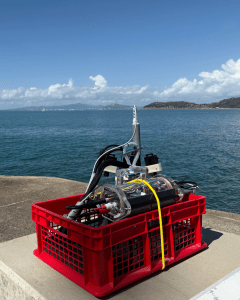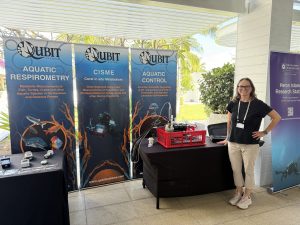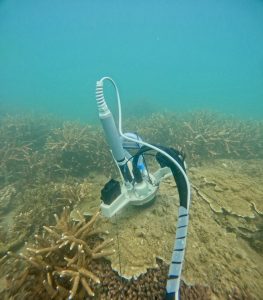When you design coral-monitoring systems from a landlocked lab in Ontario, it’s not every day you get to test one on an actual coral reef. So when the Australian Coral Reef Society (ACRS) held its annual conference in Townsville, one of the main gateways to the Great Barrier Reef, it seemed like the perfect excuse to pack a wetsuit and take Qubit’s CISME on an adventure.
Why We Went to the ACRS Conference
The conference gathered reef researchers and marine scientists from across Australia and around the world, all focused on coral preservation and the extraordinary ecosystems reefs support. For Qubit Systems, it was a valuable opportunity to meet the very researchers who use, or could use, our technology and to demonstrate the CISME system, our diver-deployed tool for studying coral metabolism directly on the reef.
One of CISME’s most important applications is helping scientists test whether certain coral species are more resilient to climate change. We also displayed some of our other marine and aquatic biology tools, including respirometry systems for studying the physiological activity of fish and invertebrates. These caught plenty of attention among the conference crowd.
Taking the Plunge
Although we build CISME, testing it on an actual coral reef is tricky from Ontario, where coral reefs are in short supply. We usually test in large seawater tanks at Qubit HQ, but the ACRS conference offered a rare opportunity for Dr. Steve Hunt, Qubit’s CEO, to dive with CISME on the Great Barrier Reef itself.
Dr. Hunt will be the first to admit he’s not a technical diver. Managing neutral buoyancy while operating a high-tech scientific instrument underwater is not something covered in most business degrees. After a few wobbly moments, he got the hang of it with help from two skilled divers from Pleasure Divers of Arcadia, QLD, who made the deployment look effortless. The dive, needless to say, was spectacular. Few office days compare to working among the world’s most beautiful coral formations.

How CISME Works
CISME stands for Coral In Situ Metabolism. In short, it’s the only diver-deployed system capable of measuring coral photosynthesis, respiration, and calcification right there on the reef. Think of it as “bringing the laboratory to the ocean.”
The diver attaches a small sampling head to the coral surface. It’s cushioned with a neoprene gasket, so the coral remains unharmed. Inside are a light source, pH probe, and oxygen sensor that track how the coral photosynthesises and respires. The system pumps seawater through a closed loop, measuring changes in oxygen and pH to monitor coral metabolism in real time.
All the data are displayed underwater on an oil-filled Android tablet that can go as deep as 80 meters. While the tablet records everything beautifully via Wi-Fi, it thankfully does not deliver emails or social media notifications. Diving remains one of the last truly offline activities.
A Few Lessons Learned
Normally, CISME is deployed from a dive boat. This time, the dive took place off Magnetic Island as a shore entry, meaning the system had to be carried from the beach to the reef. CISME travels in a floating crate, which seemed clever until the team realized that floats, of course, float. Once you need to submerge, that becomes inconvenient.
Fortunately, the professionals from Pleasure Divers came prepared with ropes and weights, so no equipment or divers drifted away. The deployment was a success, and CISME performed beautifully, providing clear and reliable measurements of coral respiration and photosynthesis right there on the reef.
Gratitude and Partners in Research
Qubit Systems would like to thank everyone who made this adventure possible, including:





